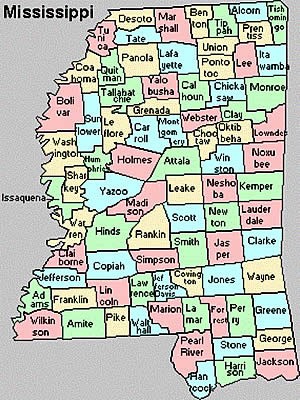Back in Time
The Evolution of Mississippi Highways
By Rickie Longfellow
In 1799, Mississippi Governor Winthrop Sargent signed a bill creating the First Road Act. When Mississippi became the 20th state in the Union on December 10, 1817, the roads were little more than meandering trails for the approximately 70,000 people who lived there. However, a bill passed that same year provided 5 percent of the net proceeds from the sale of public lands to be used for building roads and canals. From 1845 through 1860, the state became one of the nation's leading cotton producing areas. The need for better roads with more durable surfacing materials grew with the exporting of cotton.
Panola County in the northwestern part of the state built a charcoal road, which didn't last and was followed by the plank road that worked and was used for 50 years.
The first rules of the road were enacted in 1856. All carriage drivers were required to keep to the right and speed on bridges was not to exceed that of a fast walk. During this time period another law was enacted taxing landowners from one to five cents per acre, with the money to be used for road and bridge development.
All this progress was to be undone with the Civil War. Union forces destroyed the rail and land transportation system. After the destruction of the railroads, additional traffic filled the damaged roadways. Without funds, the transportation system, which had begun a century and a half earlier, was at a standstill until the turn of the century.
 |
In 1900 the highways began a rapid expansion. Although there were 20 automobiles in the entire state, the numbers multiplied quickly. Dirt and gravel were no longer sufficient roadways.
Old Highway 45 in Lee County in the northeast part of the state became the first paved road in the South. The Lee County Board of Supervisors traveled to Michigan in 1914 to investigate their paved roads and found that they lasted longer and were more cost effective than gravel. After returning home to enthusiastically report their findings, they let a contract for 49 miles of "good roads" in July 1914. The Tupelo Daily Journal of November 15, 1915 reported that Lee County had one concrete road at a cost of $8,100 per mile.
During the 1920s, Horace Stansel was appointed as head of committee to investigate highway needs. The federal government had denied federal aid until changes were made. Stansel wrote the act that became the basis for the Mississippi State Highway Department.
The Federal-Aid Highway Act of 1921 was passed and the first gasoline tax of one cent per gallon was collected the following year. In 1922, the State Highway Commission authorized district engineers to maintain all federal-aid and state-aid projects. Work began with a $200 per mile budget and 100 new road machines.
In 1924, the Legislature gained the authority to designate highways and place them under control of the Commission, provided the road was constructed to state standards.
The early 1930s, although Depression years, demanded better highways. In 1936 the legislature took advantage of a federal act providing 55-45 matching funds and authorized $23 million to be spent on roads.
The Civil War devastation of the transportation system is long forgotten. Today Mississippi has approximately 73,000 miles of highway to serve its population of over 2.5 million. Two main interstates, I-55 and I-20 intersect in Jackson, the Capitol. Two other main interstates, I-10 and I-59, offer the gateway to other states. Some 20 railroads provide freight service, and passenger trains serve about 15 cities in the state. Mississippi also has two major seaports, and the Mississippi River connects the state with many inland states. These transportation modes help distribute the state's many industries-fishing, mining, manufacturing, agriculture, petroleum, construction, wholesale and retail trading and others. A far cry from the post-Civil War days, the Magnolia state is a prosperous place to live and work.
Sources
- Mississippi Department of Transportation Web Page http://www.mdot.state.ms.us/
- Web site: KidSpace at: http://www.ipl.org/div/kidspace/stateknow/ms1.html
- A Short Course in U. S. History at: http://www.bjmjr.com/usa/eight.htm

